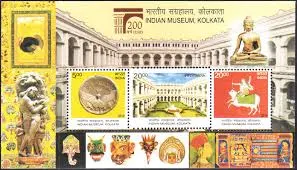The Indian Museum in Kolkata, also referred to as the Imperial Museum at Calcutta in British India era texts, is the largest and oldest museum in India and has rare collections of antiques, armour and ornaments, fossils, skeletons, mummies, and Mughal paintings. It was founded by the Asiatic Society of Bengal in Kolkata (Calcutta), India, on 2 February 1814. The founder curator was Nathaniel Wallich, a Danish botanist. It has six sections comprising thirty five galleries of cultural and scientific artifacts namely Art, Archaeology, Anthropology, Geology, Zoology and Economic Botany.
The Indian Museum originated from the Asiatic Society of Bengal which was created by Sir William Jones in 1784. The concept of having a museum arose in 1796 from members of the Asiatic Society as a place where man-made and natural objects could be collected, cared for and displayed. The objective began to look achievable in 1808 when the Society was offered suitable accommodation by the Government of India in the Chowringhee-Park Street area.In February 2, 1814, Nathaniel Wallich, a Danish botanist, who had been captured in the siege of Serampore but later released, wrote a letter supporting the formation of a museum in Calcutta which he said should have two sections - an archaeological, ethnological and technical section and a geological and zoological one.The Museum was created, with Wallich named the Honorary Curator and then Superintendent of the Oriental Museum of the Asiatic Society. Wallich also donated a number of botanical specimens to the museum from his personal collection.
The Zoological and Anthropological sections of the museum gave rise to the Zoological Survey of India in 1916, which in turn gave rise to the Anthropological Survey of India in 1945.
List of museums in India
List of museums in India
- Museum of India: Salar jung Museum, Hyderabad
- Museum of India: Baroda Museum, Vadodara
- Museum of India: Government Museum, Chennai
- Museum of India: Lucknow Museum, Lucknow
- Museum of India: Mathura Museum, Mathura
- Museum of India: Rail Museum, New Delhi
- Museum of India: Craft Museum, New Delhi
- Museum of India: India Museum, Kolkata
